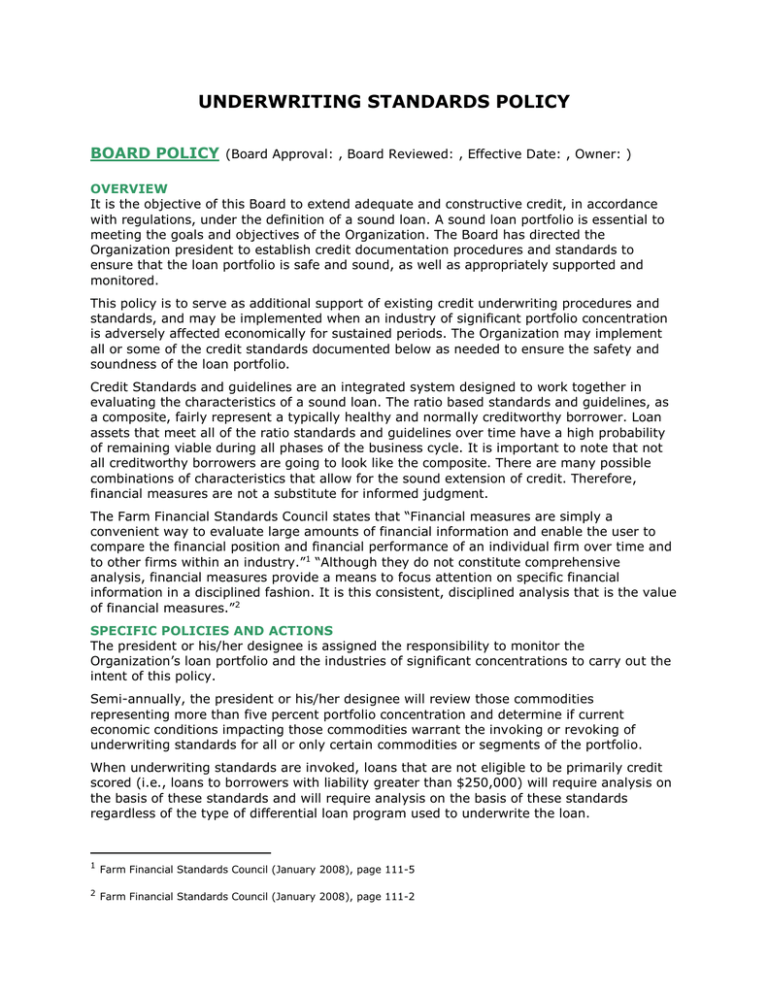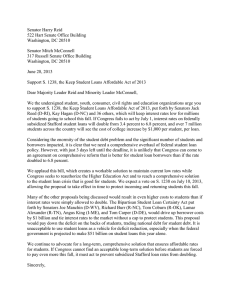English, Doc
advertisement

UNDERWRITING STANDARDS POLICY BOARD POLICY (Board Approval: , Board Reviewed: , Effective Date: , Owner: ) OVERVIEW It is the objective of this Board to extend adequate and constructive credit, in accordance with regulations, under the definition of a sound loan. A sound loan portfolio is essential to meeting the goals and objectives of the Organization. The Board has directed the Organization president to establish credit documentation procedures and standards to ensure that the loan portfolio is safe and sound, as well as appropriately supported and monitored. This policy is to serve as additional support of existing credit underwriting procedures and standards, and may be implemented when an industry of significant portfolio concentration is adversely affected economically for sustained periods. The Organization may implement all or some of the credit standards documented below as needed to ensure the safety and soundness of the loan portfolio. Credit Standards and guidelines are an integrated system designed to work together in evaluating the characteristics of a sound loan. The ratio based standards and guidelines, as a composite, fairly represent a typically healthy and normally creditworthy borrower. Loan assets that meet all of the ratio standards and guidelines over time have a high probability of remaining viable during all phases of the business cycle. It is important to note that not all creditworthy borrowers are going to look like the composite. There are many possible combinations of characteristics that allow for the sound extension of credit. Therefore, financial measures are not a substitute for informed judgment. The Farm Financial Standards Council states that “Financial measures are simply a convenient way to evaluate large amounts of financial information and enable the user to compare the financial position and financial performance of an individual firm over time and to other firms within an industry.”1 “Although they do not constitute comprehensive analysis, financial measures provide a means to focus attention on specific financial information in a disciplined fashion. It is this consistent, disciplined analysis that is the value of financial measures.”2 SPECIFIC POLICIES AND ACTIONS The president or his/her designee is assigned the responsibility to monitor the Organization’s loan portfolio and the industries of significant concentrations to carry out the intent of this policy. Semi-annually, the president or his/her designee will review those commodities representing more than five percent portfolio concentration and determine if current economic conditions impacting those commodities warrant the invoking or revoking of underwriting standards for all or only certain commodities or segments of the portfolio. When underwriting standards are invoked, loans that are not eligible to be primarily credit scored (i.e., loans to borrowers with liability greater than $250,000) will require analysis on the basis of these standards and will require analysis on the basis of these standards regardless of the type of differential loan program used to underwrite the loan. 1 Farm Financial Standards Council (January 2008), page 111-5 2 Farm Financial Standards Council (January 2008), page 111-2 The Farm Financial Standards Council recommends the use of financial measures to quantify liquidity, solvency, profitability, repayment capacity and financial efficiency. Carefully selected financial measures provide a means to assess applicant performance against accepted predetermined measurements and are intended to guide a sound lending decision. Successful operations have common characteristics. These characteristics typically indicate that they are well capitalized with adequate working capital and are consistently profitable. With this in mind the Organization has developed the following as underwriting standards: 1. Owner Equity (Equity/Asset) Ratio 2. Term Debt and Capital Lease Coverage Ratio 3. Current Ratio 4. AgScore Underwriting standards were developed for each of the Owner Equity, Term Debt Coverage and Current ratios and shall generally be evaluated on a pro forma analysis. The general standard is to be used when a high or medium dependency on a commodity specific standard is not identifiable and the respective commodity specific standard is to be used when the applicant has a high or medium dependency in that particular commodity. The AgScore standard is common to all, regardless of commodity segment. Other underwriting standards have been specifically developed for certain loans that would not typically fall under the production agriculture segments. Each respective standard documents a Norm and a Minimum standard. The Norm is documented to provide a view of the expectation of the standard to be met on an overall portfolio basis and generally reflects the characteristics of a 7-rated loan. The Minimum is the standard that must be met or exceeded by an individual credit and generally reflects the characteristics of an eight-rated loan. STANDARD #1 – OWNER EQUITY This ratio measures, on a market value basis, the proportion of total assets that is being financed by the owner’s equity capital. The ratio is calculated as follows: Total Equity divided by Total Assets times 100. Commodity General Dairy Cash Grain Forest Products Independent Poultry/Swine Beef Feedlot Orchard/Vineyard Poultry or livestock Contract Production Nursery/Greenhouse Norm 50% 60% 65% 45% 60% 50% 55% 35% 45% Minimum 40% 50% 50% 40% 50% 45% 50% 30% 40% STANDARD #2 – TERM DEBT AND CAPITAL LEASE COVERAGE RATIO This ratio measures the ability of the borrower to cover all term debt and capital lease payments. The greater the ratio, over 1:1, the greater the margin to cover the payments. The ratio is calculated as follows: [EBITD (Earnings before interest, taxes, depreciation) from Farming Operations +/- Net Cash Non-Farm Income +/- Extraordinary Income (expenses) - Total Income Tax Expense - Total Owner Withdrawals divided by Term Debt Principal and Interest Payments + Capital Lease Payments] times 100. Commodity General Norm 125% Minimum 120% Dairy Cash Grain Forest Products Independent Poultry/Swine Beef Feedlot Orchard/Vineyard Poultry or Livestock Contract Production Nursery/Greenhouse 125% 125% 125% 125% 125% 125% 125% 125% 120% 120% 120% 120% 120% 120% 120% 120% Limitations Even though the business may generate sufficient profits to cover all term debt, interest and capital lease payments, there may not be sufficient cash generated to actually make the payments on a timely basis. The liquidation or build up of inventories can make interpretation of the ratio incorrect in the short run. There is no provision in this ratio for the replacement of capital assets. If repayment schedules for large amounts of debt have interest only periods in the amortization (construction loans, etc.), the principal payments for term debt may be understated. STANDARD #3 – CURRENT RATIO This ratio measures indicates the extent to which current assets, if liquidated, would pay current liabilities. The higher the ratio, the greater the liquidity. This ratio is calculated as follows: Total Current Assets divided by Total Current Liabilities times 100. Total Current Assets include Cash, Accounts Receivable, Cash Invested in Growing Crops, Current Portion of Notes Receivable, Inventories, and Marketable Securities. Total Current Liabilities include Accounts Payable, Accrued Payables, Note Payable (due within 12 months), Current Portion of the Principal and Accrued Interest on Capital Leases, Current Portion of Deferred Taxes and Current Portion of Long-term Debt. Commodity Norm Minimum General 110% 100% Dairy 110% 100% Cash Grain 150% 125% Forest Products 125% 115% Independent Poultry/Swine 150% 130% Beef Feedlot 125% 110% Orchard/Vineyard 120% 115% Poultry or Livestock Contract Production N/A N/A Nursery/Greenhouse 115% 110% Limitations The ratio is a static concept of the capital available to meet obligations due at that given point in time. Therefore it does not predict the timing of future cash flows, nor does it ensure the adequacy of future working capital position. No indication is made of the quality of the current assets available. The ratio generally varies throughout the production cycle. STANDARD #4 – AGSCORE (For Credit Scored Loans) This score is a relative measure of the applicant’s probability of future default as calculated by Fair Isaac’s Small Business Scoring Service (SBSS) model; i.e., the higher the score, the lower probability of default. SBSS analysis includes data from the applicant’s consumer report, business report (if applicable), demographic information taken from the application and any financial information provided. Standard AgScore Norm ≥185 Minimum ≥170 If a loan scores below Minimum and underwriting standards have been invoked and applicable to the loan, then this is considered an underwriting exception requiring override authority to approve. LONG-TERM LOAN TO VALUE Standard Loan to value Norm >75% Maximum <85% All loans greater than 75% long-term loan to value are considered UW exceptions and will require override authority to approve. Collateral exceptions should be justified by offsetting strengths. AGRIBUSINESS LOANS The following standards would apply to loans being originated to eligible agri-businesses; e.g., feed mills or other retail-type businesses, who would not typically be categorized as a an agricultural production loan such as dairy, poultry, etc. These standards are based on financial statements that are completed on a cost basis in accordance with Generally Accepted Accounting Principles (GAAP). Standard (Cost Basis) LT Debt/Total Capital (%) EBITDA/Interest Total Funded Debt/EBITDA Term Debt Coverage Ratio (%) Fixed Charge Coverage Ratio Norm ≤ 55% ≥ 2.3x ≤ 4.0x ≥ 175% ≥ 1.2x Minimum ≤60% ≥ 1.9x ≤ 4.5x ≥ 150% ≥ 1.1x EBITDA is defined as earnings before interest, taxes, depreciation and amortization. EBIT is defined as earnings before interest and taxes. Total Capital is defined as total assets. Total Funded Debt is defined as debt evidenced by a note (i.e., excludes payables, accruals, deferred taxes, etc.). Fixed Charge Coverage Ratio is calculated as follows: [Operating Income + Depreciation & Amortization + Rent Expense + Interest Income + Cash Patronage Income + Cash Income from Subsidiaries & Joint Ventures – Maintenance CAPEX – Taxes – Cash Patronage Dividends Paid – Common & Preferred Dividends] divided by [Principal Payments + Interest + Rent] Maintenance CAPEX is defined as 40% of Depreciation or actual, if known. CAPITAL MARKETS PARTICIPATION/SYNDICATION LOANS OR LEASES These loans or leases are generally large and complex, and borrowers will typically have sales greater than $50 million. The following standards will apply when other commodity or industry specific underwriting standards are not deemed appropriate. Standard – General Lease Adjusted Debt/Capital Norm ≤ 60% Minimum ≤ 65% Debt/EBITDA EBITDA/Interest Fixed Charge Coverage Ratio S & P or Moody’s Rating ≤ 4.0x ≥ 2.3x ≥ 1.2x ≥ BB or Ba2 ≤ 4.5x ≥ 1.9x ≥ 1.1x ≥ BB- or Ba3 The president/CEO, or his designee, is authorized to issue more specific underwriting standards by commodity or industry that will apply to Capital Markets loans or leases. AUTHORITY TO APPROVE EXCEPTIONS Once a segment or commodity is invoked under this policy, applicable loans not meeting any one of the respective underwriting standards must be approved by the branch manager or their designee (e.g., senior portfolio manager), regional credit manager, regional manager, chief credit officer or president if the loan is within that person’s delegated authority. Loans exceeding their delegated authority must be presented to the Organization’s Credit Committee. REPORTING Once a commodity or segment is invoked under this policy: Management will monitor compliance to these underwriting standards via periodic reports that will identify all applicable loans closed and their underwriting characteristics. Loans underwritten with exception(s) require that the narrative provide a sound, documented basis for approval of the exception(s). Loans approved with underwriting exceptions will be reported quarterly in summary form to the Board of Directors.







